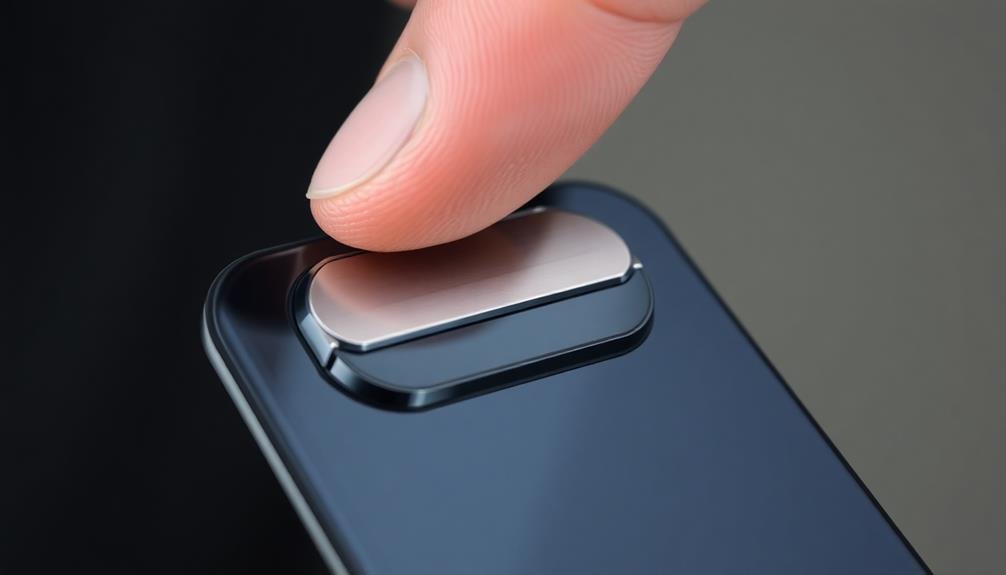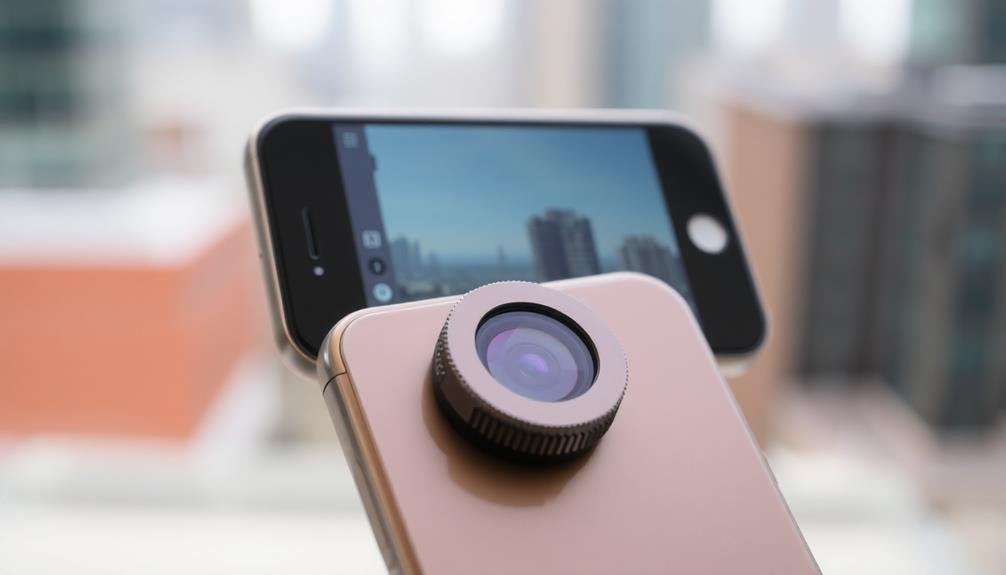To shield your phone's camera effectively, you've got several options. Physical covers like sliding mechanisms or adhesive stickers provide a simple, direct solution. Privacy-focused screen protectors can limit viewing angles, enhancing visual privacy. For a software approach, camera-blocking apps offer real-time notifications and access control. You can also customize phone cases with built-in lens covers or try DIY solutions using materials like thin plastic. Removable lens attachments serve a dual purpose, protecting the camera while expanding your photography capabilities. The best choice depends on your specific needs and usage habits. Exploring these options further will help you find the perfect balance between protection and functionality.
Understanding Camera Lens Vulnerability

Your phone's camera lens is more vulnerable than you might think. It's exposed to various threats that can compromise its functionality and your privacy. Scratches from keys, coins, or other objects in your pocket or bag can damage the lens surface, affecting image quality.
Dust and debris can accumulate, leading to blurry photos and potential long-term damage. Moreover, your camera is susceptible to hacking. Cybercriminals can exploit vulnerabilities in your phone's software to gain unauthorized access to your camera, potentially capturing sensitive information or spying on you.
Even seemingly harmless apps might request unnecessary camera permissions, putting your privacy at risk. Physical damage isn't the only concern. Prolonged exposure to direct sunlight can harm the camera's delicate sensors and internal components.
Extreme temperatures, both hot and cold, can also affect the lens's performance and lifespan. Water damage is another significant threat, especially for non-waterproof devices. Even small amounts of moisture can fog up the lens or corrode internal parts.
Understanding these vulnerabilities is vital for implementing effective protection measures and maintaining your phone camera's integrity and your privacy.
Physical Covers and Sliders

Camera shields offer a straightforward solution to protect your phone's lens and safeguard your privacy.
These physical covers come in various forms, from adhesive stickers to sliding mechanisms integrated into phone cases. They're designed to block your camera when it's not in use, preventing unauthorized access or accidental recordings.
When choosing a camera shield, consider these factors:
- Ease of use: You'll want a cover that's quick to open and close
- Durability: Look for materials that can withstand daily wear and tear
- Compatibility: Verify the shield fits your specific phone model
- Aesthetics: Choose a design that complements your device's appearance
Many users prefer sliding covers for their convenience and reusability.
These often come built into protective cases, offering a two-in-one solution for privacy and device protection. Adhesive stickers, while simpler, may need replacing over time and can leave residue on your phone.
Privacy-Focused Screen Protectors

While physical covers protect your camera lens, privacy-focused screen protectors offer a different approach to safeguarding your visual privacy.
These specialized screen protectors use advanced technology to limit the viewing angle of your phone's display, making it difficult for onlookers to see your screen content.
When you apply a privacy screen protector, you'll notice that your screen appears normal when viewed straight on. However, from side angles, the display becomes darkened or blurred, effectively preventing visual snooping.
This feature is particularly useful in public spaces, such as crowded trains or open offices, where others might inadvertently glimpse your screen.
Some privacy screen protectors also incorporate additional features like blue light filtering or anti-glare properties.
While they don't directly shield your camera, they complement your overall privacy strategy by protecting the information displayed on your screen.
It's important to note that privacy screen protectors may slightly reduce screen brightness and clarity.
They're also not a foolproof solution against determined surveillance efforts.
However, for everyday privacy concerns, they provide an effective and unobtrusive layer of protection that doesn't interfere with your camera's functionality.
Software-Based Camera Blocking Solutions

In the digital domain, software-based camera blocking solutions offer a flexible alternative to physical covers. These apps and programs allow you to disable your phone's camera with a tap or automatically based on your settings. They're particularly useful if you're concerned about malware or unauthorized access to your camera.
Some popular software solutions include:
- Camera Blocker apps
- Privacy Guard features in security suites
- Built-in OS privacy settings
- Custom ROMs with enhanced privacy controls
When choosing a software solution, consider its compatibility with your device and operating system. Look for options that offer real-time notifications when apps attempt to access your camera.
Some advanced solutions even provide virtual cameras, which feed fake data to apps requesting camera access.
Remember that software solutions aren't foolproof. They can be bypassed if your device is compromised at a deeper level. For maximum protection, combine software blocking with physical covers or privacy-focused screen protectors.
Also, keep your device's operating system and security software up to date to minimize vulnerabilities. By employing a multi-layered approach, you'll greatly enhance your camera privacy and overall device security.
Customizing Phone Cases

Your phone's case can serve as more than just protection—it can also be a stylish and functional camera shield. Many companies now offer cases with built-in sliding covers for your phone's cameras. These allow you to quickly uncover the lenses when you want to take a photo and cover them when you're not using them.
If you're feeling creative, you can customize your own case with a DIY camera cover. Use adhesive-backed felt or fabric to create a small flap that covers your camera lens. Attach it to the inside of a clear phone case for a sleek look.
Alternatively, you can add a small, removable sticker over your camera lens that you can easily peel off when needed.
For a more robust solution, consider a heavy-duty case with a built-in camera cover. These often feature a rotating or sliding mechanism that protects your lenses from scratches and unwanted access. Some even come with locks for added security.
DIY Camera Shield Options

You've got several DIY options for shielding your phone's camera.
Sliding camera covers offer a sleek, built-in look, while adhesive sticker shields provide a quick and easy solution.
For a more versatile approach, you can opt for folding privacy flaps that allow you to quickly conceal or reveal your camera as needed.
Sliding Camera Covers
Many DIY enthusiasts have discovered a simple yet effective solution for camera privacy: sliding camera covers. These compact accessories attach to your phone's camera lens, allowing you to manually open and close the cover as needed.
You can easily make your own sliding camera cover using materials like thin plastic, adhesive tape, and a small piece of metal or plastic for the slider.
To create a sliding camera cover, you'll need:
- A small piece of thin, flexible plastic
- Strong adhesive tape
- A tiny metal or plastic slider
- Scissors or a craft knife
Cut the plastic to fit your phone's camera area, leaving room for the slider to move. Attach the slider to the plastic using the adhesive tape, ensuring it can glide smoothly.
Finally, secure the cover to your phone with more adhesive tape, making sure it doesn't interfere with your device's functionality.
Sliding camera covers offer a practical way to protect your privacy without compromising your phone's aesthetics. They're easy to use, inexpensive to make, and provide peace of mind when you're not using your camera.
With a little creativity, you can customize your sliding cover to match your phone's style or express your personality.
Adhesive Sticker Shields
Creating adhesive sticker shields offers another simple DIY solution for protecting your phone's camera. You can easily make these shields using materials you likely have at home. Cut small circles from opaque tape, card stock, or even old gift cards to fit over your camera lens. For added convenience, use double-sided tape to make the shields removable and reusable.
When designing your sticker shields, consider aesthetics and functionality. Choose colors or patterns that complement your phone's design. You might even add a personal touch with mini artwork or logos. Remember to keep the shield thin enough to avoid interfering with your phone case.
Here's a quick guide to DIY adhesive sticker shields:
| Material | Pros | Cons |
|---|---|---|
| Opaque tape | Easy to apply, thin | May leave residue |
| Card stock | Customizable, sturdy | Can be bulky |
| Gift card plastic | Durable, water-resistant | Harder to cut precisely |
While adhesive sticker shields are cost-effective and customizable, they may not provide the same level of protection as dedicated sliding covers. However, they're an excellent option for those who want a quick, easy solution to camera privacy concerns.
Folding Privacy Flaps
Folding privacy flaps offer a versatile and reusable DIY option for shielding your phone's camera. These flaps are typically made from thin, flexible materials like plastic or fabric and can be easily attached to your device. You'll find that they're particularly useful if you want a quick and reversible way to cover your camera when not in use.
To create your own folding privacy flap, you'll need some basic crafting supplies and a bit of creativity. Here are some key points to take into account:
- Choose a material that's durable yet thin enough to fold smoothly
- Confirm the flap is sized correctly to cover your camera lens completely
- Use a strong adhesive that won't damage your phone's surface
- Design the flap with a tab or handle for easy opening and closing
When crafting your folding privacy flap, remember to test its functionality before permanently attaching it to your phone. You'll want to make sure it doesn't interfere with your device's case or other accessories.
With a well-designed folding privacy flap, you can enjoy peace of mind knowing that your camera is shielded when you're not using it, while still having quick access when you need to snap a photo.
Removable Lens Attachments

Removable lens attachments offer you a versatile way to protect your phone's camera while expanding its capabilities.
You'll find a wide range of options, from fisheye to macro lenses, that easily clip onto your device.
These attachments not only shield your camera when in use but also come with protective cases for safekeeping when detached.
Variety of Lens Options
The world of removable lens attachments for your smartphone camera opens up a vast array of creative possibilities. You'll find a wide variety of lens options to enhance your photography skills and expand your creative horizons.
From ultra-wide-angle lenses for capturing sprawling landscapes to macro lenses for intricate close-ups, there's a lens for every situation. Fisheye lenses offer a unique, distorted perspective that's perfect for artistic shots, while telephoto lenses allow you to zoom in on distant subjects without losing image quality.
You can even find specialty lenses like anamorphic or tilt-shift options for more advanced effects. Here are some popular lens types you might consider:
- Wide-angle lenses for expansive landscapes and architecture shots
- Macro lenses for extreme close-ups of small objects
- Telephoto lenses for capturing distant subjects or wildlife
- Fisheye lenses for creative, ultra-wide perspectives
When choosing a lens attachment, consider factors like compatibility with your phone model, ease of use, and image quality. Many lens kits come with multiple options, allowing you to experiment with different styles and find your favorite.
Remember to keep your lenses clean and protected to guarantee the best possible results in your mobile photography adventures.
Easy Attachment Mechanism
In addition to the variety of lens options available, one of the most appealing aspects of removable lens attachments is their easy attachment mechanism.
You'll find that most lens attachments use either magnetic or clip-on systems, allowing you to quickly secure and remove them from your phone's camera.
Magnetic attachments often require you to stick a small metal ring around your phone's camera lens. Once in place, you can easily snap on different lenses as needed. This method provides a secure fit while maintaining a sleek profile.
Clip-on systems, on the other hand, use a spring-loaded mechanism to grip your phone. They're versatile and don't require any permanent modifications to your device.
Both attachment types are designed for quick swapping, so you can change lenses on the fly. You'll appreciate this convenience when you're out shooting and need to switch between wide-angle, macro, or fisheye lenses.
The ease of use extends to storage and portability as well. Most lens attachments come with protective cases or pouches, allowing you to safely carry them in your pocket or bag without worrying about damage or scratches.
Protection During Storage
Safeguarding your removable lens attachments during storage is vital for maintaining their quality and longevity. When you're not using your camera accessories, it's important to store them properly to prevent damage and guarantee they're ready for your next photo session.
To protect your removable lens attachments during storage, consider these key points:
- Use padded cases or pouches designed specifically for camera lenses.
- Store attachments in a cool, dry place away from direct sunlight.
- Keep silica gel packets in your storage containers to absorb moisture.
- Regularly clean and inspect your attachments before storing them.
You'll want to invest in a dedicated storage solution for your lens attachments. Opt for a case with individual compartments to prevent scratches and collisions between different pieces.
If you're traveling, consider a hard-shell case for extra protection against impacts.
Don't forget to cap both ends of your lens attachments before storing them. This simple step prevents dust and debris from accumulating on the glass surfaces.
If you're storing multiple attachments together, use lens separators or wraps to add an extra layer of protection.
Balancing Protection and Functionality

Finding the sweet spot between protection and usability is essential when shielding your phone's camera. You'll want to guarantee your camera is safe from scratches and damage without compromising its functionality or image quality.
Opt for slim, clear lens protectors that don't interfere with your phone case. These allow you to maintain the camera's performance while adding a layer of protection.
Consider flip covers or sliding lens covers that you can easily open when you're ready to take a photo. These provide excellent protection when you're not using the camera but require an extra step before shooting.
If you prefer constant readiness, look for cases with raised bezels around the camera lenses. They'll protect your camera from flat surface contact without obstructing your shots.
Be wary of bulky cases or covers that might affect your phone's overall ergonomics or wireless charging capabilities. Test different options to find what works best for your usage habits.
Frequently Asked Questions
Can Camera Shields Affect the Quality of Photos When Removed?
Camera shields shouldn't affect photo quality when removed, as long as you're careful. However, residue or scratches from frequent shield use might impact your lens. It's best to clean your camera thoroughly after removing any shield.
Are There Any Legal Issues With Using Camera Shields in Certain Places?
You should be aware that using camera shields may be restricted or prohibited in certain locations. It's best to check local laws and regulations before using them, especially in sensitive areas like government buildings or private establishments.
How Do Camera Shields Impact Facial Recognition and Biometric Security Features?
Camera shields can considerably impact facial recognition and biometric security features. When you cover your phone's camera, you'll likely disable these functions. They won't work properly without a clear view of your face or other biometric data.
Can Camera Shields Interfere With Augmented Reality (Ar) Apps and Features?
Yes, camera shields can interfere with AR apps and features. When you cover your phone's camera, you'll block its ability to capture real-world images, which are essential for overlaying digital content in augmented reality experiences.
Are There Professional-Grade Camera Shields Used in High-Security Environments?
Yes, there are professional-grade camera shields for high-security environments. You'll find specialized covers, electronic jammers, and physical blockers designed for sensitive locations. They're often custom-made and rigorously tested to guarantee complete protection against unauthorized surveillance or recording.
In Summary
You've got plenty of options to shield your phone's camera. Whether you choose physical covers, specialized screen protectors, or software solutions, pick what works best for your needs. Don't forget to contemplate DIY alternatives or customized cases if you're feeling creative. Remember, it's all about finding the right balance between protection and usability. With these methods, you'll be able to safeguard your privacy without sacrificing your phone's functionality.





Leave a Reply